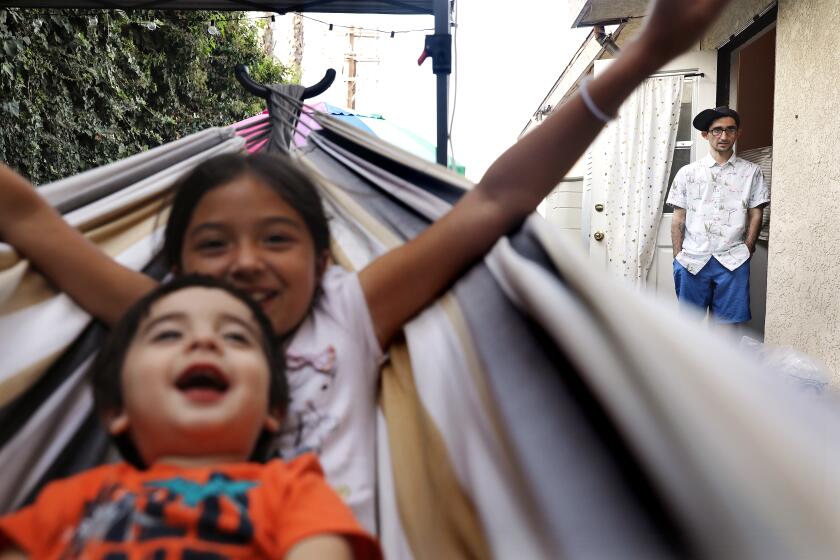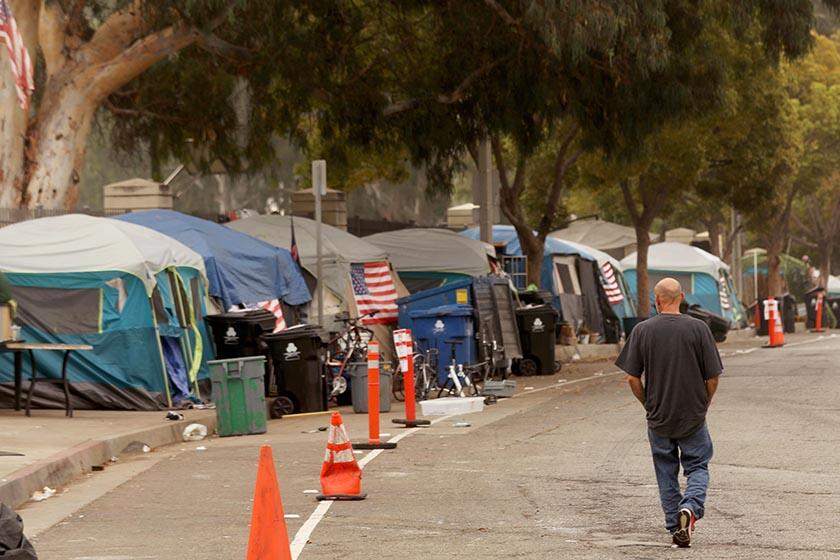CARE courts open in a month, promising hope for families. Not everyone is so sure
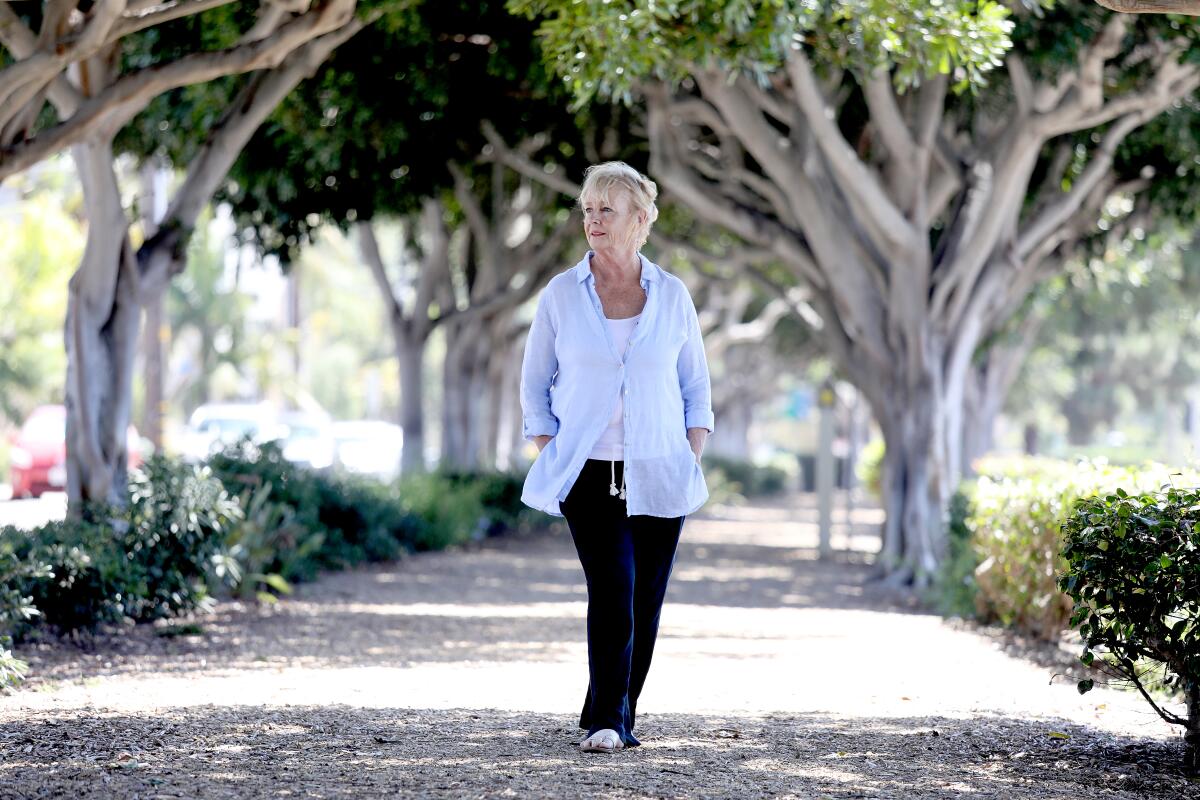
- Share via
Nan Ibarra knows what psychosis looks like and wonders whether politicians do.
Not long after her older son became convinced that she was Satan, he took a baseball bat to their Laguna Hills home, smashing windows, framed pictures and a curio cabinet.
Then his brother began taking spoonfuls of sugar into the backyard because ants told him they were hungry.
Having watched the effect of schizoaffective disorder on her two sons, Ibarra knows how unpredictable its symptoms are. In the last 3½ years, her younger son has been hospitalized 45 times, she said; his brother is in a sober-living home.
So when Ibarra first heard about the Community Assistance, Recovery and Empowerment Act, she wondered why lawmakers were so focused on voluntary compliance.
“I am open to CARE Court,” she said, “but am naturally recoiling because of its voluntary nature. My sons have never done any program that allows them to choose.”
Seven counties will open their CARE Courts on Oct. 1. The state has estimated that 7,000 to 12,000 people will qualify for a treatment plan.
Ibarra, who now lives in Idaho but oversees her sons’ care and treatment on regular trips to Orange County, is voicing a concern that has emerged among some families as details of the legislation have become clearer in recent months.
“Dealing with someone with serious mental illness is very unpredictable,” said Elaine Tan of Irvine, whose son has been diagnosed as having schizoaffective disorder. “How many people with serious mental illness will voluntarily follow through with their care? It’s part of the illness not to. It’s part of the brain deficiency that they won’t.” (Tan asked to be referred to by her maiden name to protect her son’s privacy.)
With just weeks before CARE courts in select counties begin accepting cases, a complicated picture has emerged of families who feel the new law does too little to treat those with severe mental illness and civil libertarians who fear it will do too much.
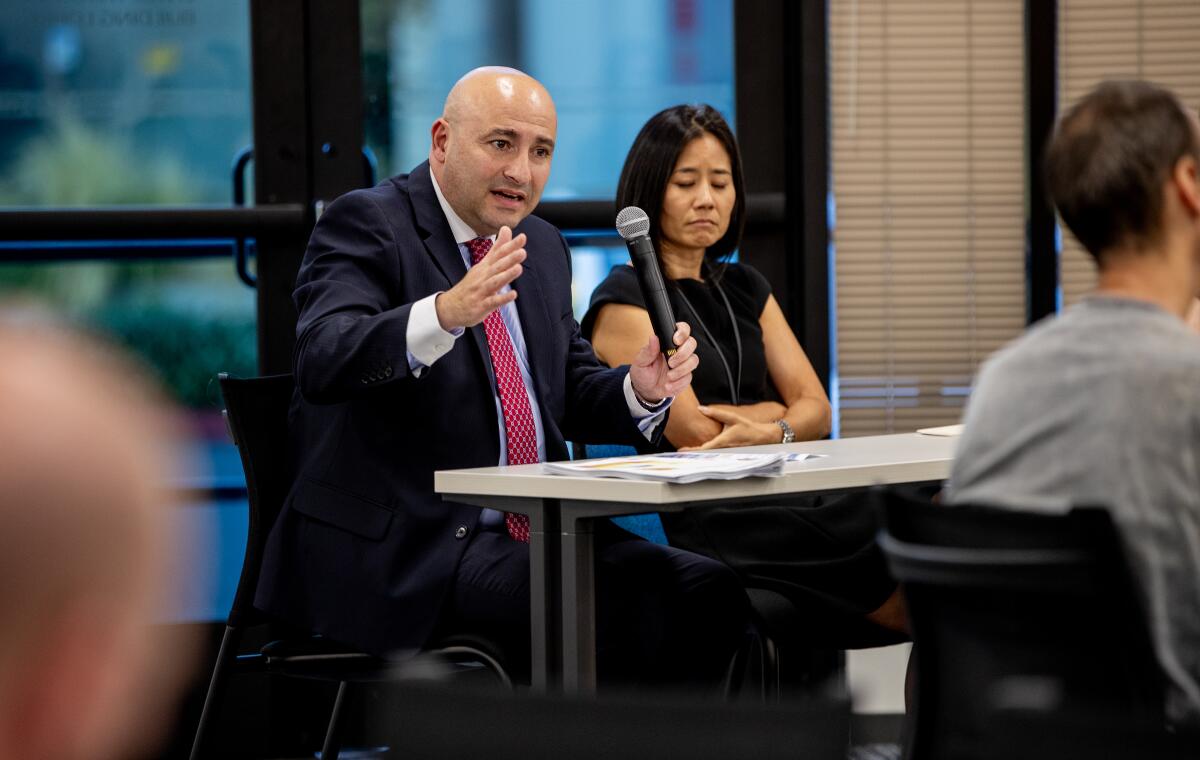
Athough the law does not explicitly address what can be done if a person refuses to comply with a treatment plan prescribed by the court, Clare Cortright, policy director of Cal Voices, anticipates coercive measures.
“To say that a CARE agreement is voluntary is like saying a plea agreement is going to prison voluntarily,” said Cortright, whose Sacramento-based nonprofit advocates for people with mental illness.
The CARE Act — like other attempts to legislate treatment for severe mental illness in California — is constrained by the Lanterman-Petris-Short Act.
Orange County among the first
Seven counties, including Orange, will open their CARE courts on Oct. 2. Los Angeles County‘s opens on Dec. 1, and the rest of the state has until next year to follow suit.
The families’ disappointment is in contrast to their enthusiasm last September when Gov. Gavin Newsom signed the bill, which was considered the most significant reform to the state’s behavioral health laws since the 1967 Lanterman-Petris-Short Act, known as LPS.
The CARE Act opened a door for more people, including family members, to petition the court to request treatment for loved ones experiencing psychoses.
Previous legislation had focused on involuntary commitment as a means for treatment, and only police, crisis teams and mental health providers could make that request. As a result, families found themselves on the sidelines, unable to get help and, once help was provided, excluded from the process by medical privacy laws.
The life of a 31-year-old living with schizophrenia illustrates the toll of illness and the challenge of getting severely mentally ill people off the streets.
But now families are worried that even though they can petition for treatment, they will be shunted aside. Their loved ones, referred by the CARE Act as respondents, may refuse to have families follow their progress and may also refuse treatment.
“What 2-year-old will willingly do the things you want them to do?” Ibarra said. “I am constantly dealing with a 2-year-old. I’m telling him this is the best thing for you, and he says no and walks back to the street, to drugs and off his meds.”
How judges will react in the face of such defiance worries the legislation’s most vocal critics, who argue that it will become an effective means for getting respondents into treatment involuntarily.
As an attorney, Cortright said that she has represented 2,000 people on involuntary holds and that her clients have overwhelmingly had a horrible experience. The CARE Act, she believes, will be equally traumatic.
‘A lot of tension’
“It is one thing to talk about the program from afar, but what does it look like and feel like for the person going through it?” she asked, describing the prospect of someone having to stand in front of a judge and talk about their mental condition. “It is humiliating. It strips away your privacy. It makes your health a crime.”
Nor does Cortright see evidence that the CARE Act will work. Its protocols, she said, are based not on data but on society’s exasperation with homelessness and mental illness on the streets.
In L.A. County, CARE Court will be implemented next year. Here’s how you can access it.
Dr. Veronica Kelley, the director of behavioral health services in Orange County, who heads the region’s rollout, is preparing for disappointment against expectations.
“There is a lot of tension throughout the system,” she said before giving a presentation to a gathering of families and caregivers in Orange.
::
Legislating the treatment of severe mental illness in California will always be shadowed by the past. The Lanterman-Petris-Short Act transformed decades of institutionalized care that was often tragically coercive.
The CARE Act tries to not repeat that pattern.
Once the petition is approved by a judge, the respondent is contacted and a treatment plan is drawn up. Once the plan is approved by the judge, the respondent may accept its terms or choose not to.
Acceptance sets a course of treatment for at least one year, including behavioral health and social services, medication management and housing. Refusal results in being called before the judge, who decides the next step.
The process leans heavily upon “supportive decision making,” which appoints a “supporter” — defined in the legislation as someone who helps the respondent “understand, make, communicate, implement or act on their own life decisions during the CARE process.”
Health Management Associates, a Michigan-based consulting firm under contract with the California Department of Health Care Services, introduced the concept this year to a working group helping to implement the legislation. Its rationale was described as “a response to decades of suppression of the rights of people with disabilities to make their own decisions.”
Potential exclusion worries parents
The respondent is given an opportunity to choose their supporter, who may or may not be a family member or the petitioner.
This potential exclusion worries families who question why the CARE Act makes no provision for their continued involvement even if they filed the petition.
Mark Gale, criminal justice chair of the National Alliance on Mental Illness for greater Los Angeles County, sees a strong anti-family bias in the legislation.
“Some stakeholders are concerned that families might put undue pressure on the respondent,” he said. “What they don’t understand is that families would be thrilled if their loved ones would accept treatment voluntarily, but we all know that doesn’t happen as much as we would like.”
“We want to be partners in care,” said Teresa Pasquini, who for 20 years has advocated for her son, who has schizophrenia. She feels families have been disregarded and disdained in every meeting.
Pasquini is concerned that implementation of the CARE Act has focused upon “equity, ethnic and cultural-focused conversations” but avoided important conversations about families and the role these relationships play in the dynamic of mental illness.
“The culture of families like mine, who have faced multiple traumas while being blamed and shamed for the no-fault brain illnesses of our loved one, must not be disrespected or glossed over,” she said.
The author of the CARE Act, state Sen. Tom Umberg (D-Orange), hopes to bring families back into the process with what he calls a “cleanup bill,” Senate Bill 35. It would allow the court to assign “ongoing rights” to the original petitioner but only if the court and respondent agree. (The bill also waives the $433 fee for filing a petition.)
Excluding families, Gale and Pasquini say, is a mistake and an example of how the CARE Act insufficiently balances effective treatment with the autonomy of respondents.
“There is too much emphasis on making them feel good with the assumption that they are thinking clearly and their rights should be preserved,” Ibarra said.
Although Ibarra supports the legislation’s push for supportive decision making, she doubts that it will lead to a more consensual treatment plan. She describes how on some days one son is completely lucid and rational and on other days he claims that she is not his mother but a clone.
“Inside his head, everything is suspect,” she said. “It doesn’t matter if he is in a room with flowers.”
Effective treatment, Ibarra believes, should be both compassionate and forceful, and the respondent should be held accountable.
When her older son was arrested for driving under the influence and tried in a collaborative court for mental illness, the judge ordered two ankle bracelets and random drug and alcohol tests. Three years later he is sober and medication-compliant.
But when his brother became symptomatic, Ibarra saw how agencies treated him with greater sensitivity and, in her opinion, were less effective.
“They said that they don’t want to impinge on him and make him feel nervous and scared,” she said, “without taking into account that his thoughts and emotions change like the wind.”
Supportive decision making, said Rod Shaner, former medical director of the Los Angeles County Department of Mental Health, is a “fulcrum of the CARE Act” but does not directly address someone’s capacity or incapacity to think rationally based on their illness.”
Families can help because they have experience with the respondent’s illness, the delusions and paranoia, Gale and Pasquini say, and at the very least, families should be allowed to provide the medical history of their loved ones.
Cortright is wary of such arguments and in particular the influence that families can have on legislators.
“Family members are saying, ‘I’m at my wit’s end dealing with my loved one,’ but we can’t make policy based on anecdotes. We’re writing laws that affect millions of people in perpetuity; you make laws that do the most good for the most people,” Cortright said.
‘Let’s stop walking on eggshells’
She is mostly concerned, though, that a bad experience with CARE Court will discourage respondents from participating in the system.
“At the end of the day if what you’re doing is harming and turning them off to the mental health system, then as soon as your finger is off the scale, they will say go to hell and walk away,” Cortright said.
What’s needed instead is a relationship based on trust, and that takes time, she said. “You have to balance treatment with quality of life. If you’re going so far in quest of treatment and degrading quality of life, people will resist you.”
::
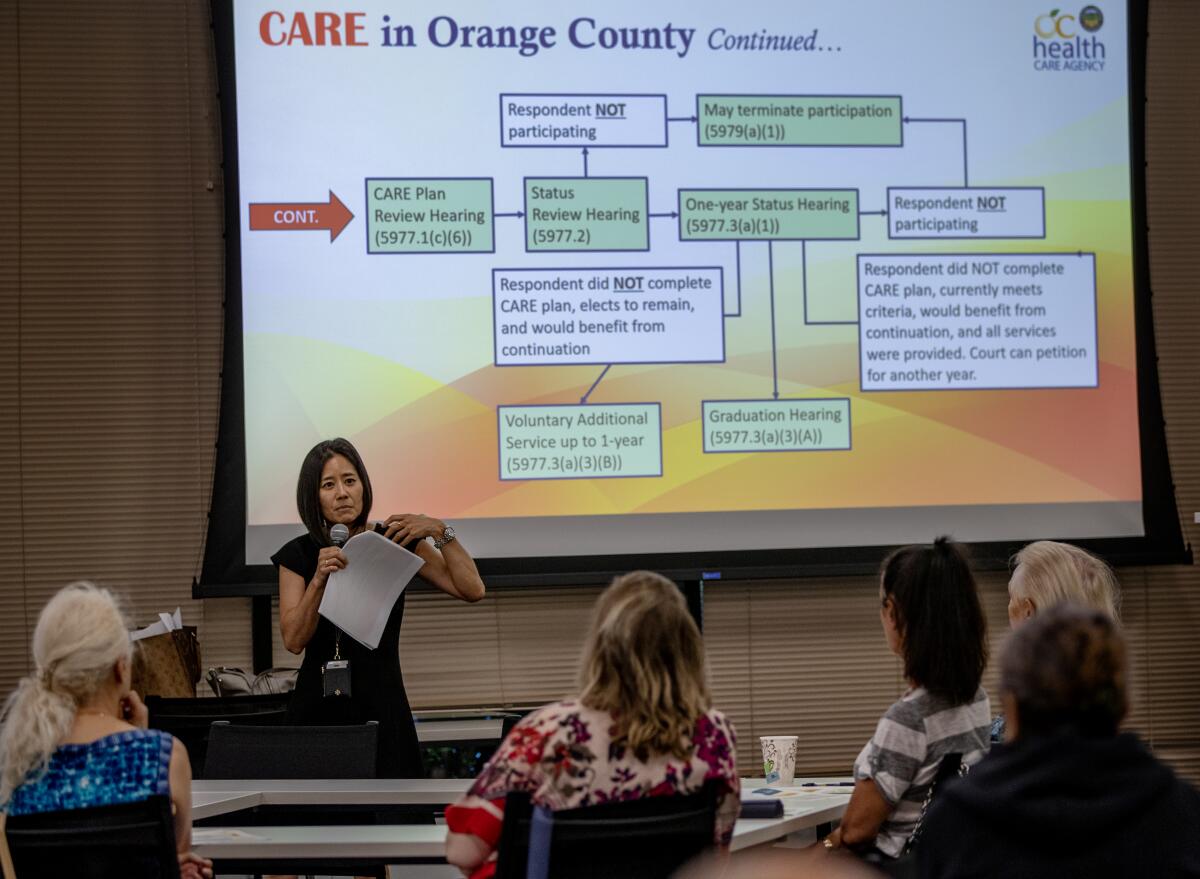
The CARE Act, said Dr. Susan Partovi, medical director of Homeless Health Care Los Angeles, a nonprofit that provides healthcare for the homeless residents of Los Angeles, is “very coercion-averse. There is a lot of ‘we don’t want to make anyone do what they don’t want to do.’
“Let’s stop walking on eggshells to make sure we’re not pissing off the ACLU or Disability Rights California and take this opportunity to get people the help that they need.”
Getting someone into treatment will take patience and particular skills for presenting resources to someone who is suspicious and paranoid, Partovi said. Having a judge and a court involved will probably alienate many people who need help.
“My hope is that the actual outreach workers — or people petitioning the courts — have the wherewithal to know that it is going to be a discussion over time, and just because they say ‘no’ the first time, doesn’t mean you’re done,” she said.
In her meeting with the 35 people gathered in Orange to learn about the act, Kelley described the lengths to which Orange County will go to bring someone into treatment. She knows that some respondents may require numerous interactions with staff and the volunteer supporter.
“Our job is to work with them so they can feel safe enough to trust us,” she said.
The goal — and hope — of the CARE Act is that the respondent’s decision is the same as the court’s, which would preclude the potentially traumatic experience of having to stand before a judge.
“The best success is no one has to see me,” said Orange County Superior Court Judge Ebrahim Baytieh, who will oversee the county’s CARE Court.
Although the CARE Act is not “an on-ramp to conservatorship,” he added, “if someone goes through the CARE Act process and doesn’t succeed, there is a presumption that they may be eligible for involuntary conservatorship,” as defined by the Lanterman-Petris-Short Act.
The overlap between the CARE Act and other existing LPS codes — where voluntary treatment becomes involuntary commitment — remains a gray area that will probably require coloring in, Shaner said.
Although the CARE Act tries to preserve less restrictive treatment, there has to be clarity about what comes next if there is the presumption that the respondent needs help, he added.
“There has to be a backstop, so they don’t just disappear back into the streets and die,” Shaner said.
More to Read
Sign up for Essential California
The most important California stories and recommendations in your inbox every morning.
You may occasionally receive promotional content from the Los Angeles Times.

